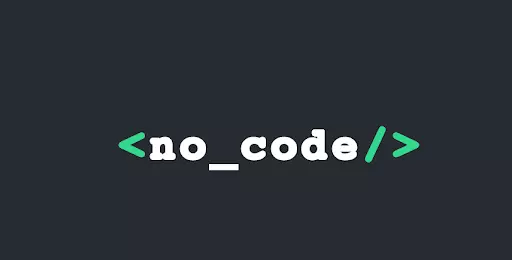
Excerpt: No-code is the new thing in software development that brought a revolution by making people’s lives easy in building software. In our article we wanted you to know why and how no-code brought the revolution and how you can make use of it.
Read Time: 6 mins
Application Modernisation
In a time when for businesses it is a struggle to find or afford developer talent then they often turn to low-code platforms. According to a Tuesday analysis from no-code vendor Quick Base, these platforms may improve efficiency, collaboration, workflow integration, and customer service, and in many circumstances, become a required component of the organization.
Nearly nine out of ten no-code platform users indicated their positions are crucial to corporate success, saying that they directly benefited business performance, according to the 318 customer businesses questioned globally.
But what is this no-code?
What is No-Code?
No-code frameworks are software development tools that enable even non-technical persons to run apps without writing a single line of code. These tools typically include a user-friendly interface and drag-and-drop functionality, allowing you to easily see the implementation process and express the overall business logic.
A no-code framework is a programming platform that uses a visual development interface to allow non-technical people to construct apps by dragging and dropping software components. No-code users don’t need any prior coding skills to create applications.
Also, here let’s give you a quick understanding of the specific term called No-Code development platform.
What is a No-Code Development Platform?
A no-code platform is a programming platform that uses a visual development interface to allow non-technical people to create whole apps by dragging and dropping software applications. No-code allows users to create applications without any prior coding skills. It seemed too unbelievable to be true. Non-technical business customers were creating full-fledged applications!
After understanding what is no-code, the question that you might be thinking is what is making no-code being called a revolution. We would say it is the benefits or the aid that no-code provides to businesses in terms of software growth. So let’s see how no-code can help you.
How Can No-Code Help You?
The aid that no-code provides can be summarised in just simple three key points.
- Fast- Not only can you produce software faster, but you can also automate operations using no-code and increase efficiency.
- Cheap- You can just cancel out the cost of hiring developers, by just spending a few thousand bucks and begin with a tool to build software.
- Easy- No need to learn how to write code, with simple tools you can do it.
Anything that gives you these three benefits will make businesses run behind them anyways and revolution would be there.
Right now after all the benefits, we should know how to do it. So, we will tell you how to get started with no-code.
How To Get Started With No-Code?
We don’t want you to go on and on about how to start with no-code. We made it simple with just 5 steps to get started with no-code.
1.Be Precise With Your Why
Yes, this is a very intriguing area. However, as a business owner, your time is limited, and there are always opportunity costs to consider, so don’t get caught up in the no-code craze just because it’s trendy. Rather do it because it contains relevant use cases that can help you speed your startup.
Before you start worrying about which no-code tool to use and other such details, you need first figure out why you want to use this area in the first place. Some of your reasons may be:
- Build your MVP
- Optimise the efficiency of existing operational processes
- Rapidly prototype new product features
- Stay informed on the latest developments in no-code
- Create growth tools
Be it a reason or a combination, you should make a note of the reasons why you are choosing it.
This is vital because no-code is always evolving and changing, so it’ll be easy to become lost and sidetracked if you don’t have a yardstick to judge your progress against.
2.Choose Your Toolbox
It’ll be easier to choose which tools to learn and build with now that you know why you’re doing it. We suggest that you be very specific while picking up your tool.
While some tool platforms have a first-mover advantage, the landscape will look very different in a year or two. No-code is still early and has yet to reach anywhere near maturity, so while some tool platforms have a first-mover advantage, that doesn’t mean the landscape won’t look very different in a year or two.
With this in mind, it makes more sense to create by use case rather than focusing on one tool in particular.
There are so many tools available out there, it would be a good idea for you to keep in mind the versatility and useful stack that can meet the most while choosing one.
3.Join a Community
So now you know why you’re doing it and what tools you’ll need to get started. The difficult thing now is figuring out how to use these technologies – and the no-code space in general – to your benefit.
Here’s where the concept of community comes into play. Here are five compelling reasons to join:
- Accountability- Learning a new skill is difficult, but having someone to hold you accountable will help you progress.
- Shared Knowledge- Members of a good community assist one another. If you’re learning alone, you will receive access to the tips, tactics, tools, or time that other people studying the same skill as you.
- Collaborations- 70% of no-coders aim to use these technologies to start a company. As a result, becoming a part of a no-code community will provide you with access to not only people studying the same skill as you but also entrepreneurs. This might lead to one-time Zoom calls or full-fledged co-founding collaborations.
- Expert Help- Even though the no-code area is still in its early stages, some people have been around for a while and are experts in one or more tools. So, if you ever get stuck, you can always turn to your community’s power users.
- Inspiration- The rate at which people in the community launch things is inspiring, guilt-inducing, and motivating all at the same time, so surrounding yourself with these people can only be beneficial.
4. Start Learning
You’re all set to start learning.
Even though these no-code solutions have a much flatter learning curve than coding, that doesn’t mean they’ll be easy to use.
It’s difficult to choose which tools to use and finding the best resources to learn them is much more difficult.
Each tool will have different resources to learn from. You can search them online and get access to them.
5. Build Now
This step isn’t followed by the one before it. Learning and construction should be placed together.
It’s all too easy to get caught up in a consuming cycle, believing that each new video, article, or podcast will improve your skills with these tools. That is not the case. In fact, until you use these techniques, you won’t know where you stand.
A project-based learning strategy was employed by the No-coders who learned the most quickly.
You should do the same. Make something with each new tool you get, whether it’s a fun, throwaway endeavour or something you’ll need later.
Quick Takeaways
And it’s a wrap. Just keep in mind:
- Determine your why to help you choose the tools you wish to learn and apply.
- Make little initiatives that will assist your startup to focus on building rather than consuming.
- To push your no-code game and startup to new heights, join a community.










